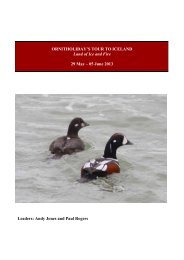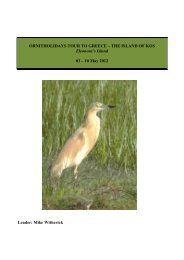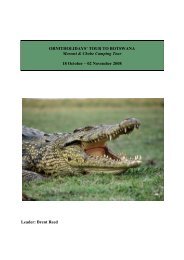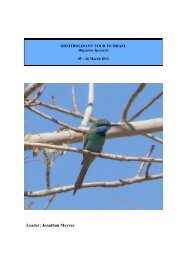Download 2014 Brochure (.pdf) - Ornitholidays
Download 2014 Brochure (.pdf) - Ornitholidays
Download 2014 Brochure (.pdf) - Ornitholidays
Create successful ePaper yourself
Turn your PDF publications into a flip-book with our unique Google optimized e-Paper software.
P O R T U G A L<br />
Osprey<br />
Great Bustards<br />
(not an easy species in these parts!). We will eat<br />
our picnic lunches on a heath-covered cliff-top,<br />
keeping an eye on the sea for passing gulls and<br />
terns with the chance of a Peregrine Falcon<br />
stooping on Rock Doves resident on the cliffs.<br />
Suitably refreshed we will drive down to the Cabo<br />
de Sao Vicente. Besides admiring the scenery,<br />
we will look for Black Redstart, Red-billed<br />
Chough, Tawny Pipit and perhaps some migrants<br />
using this location as a stepping stone in their<br />
southward journey to Africa. If we have time, a<br />
period of sea-watching should allow us to see<br />
passing Cory’s and Balearic Shearwaters, skuas<br />
and terns. It is here also that we may become<br />
most aware of the raptor migration pathway that<br />
cuts across south-western Portugal. Likely<br />
migrants include Booted and Short-toed Eagles,<br />
European Honey Buzzard and Osprey. During the<br />
remainder of the afternoon we will visit two<br />
lagoonal areas along the south coast. Hopefully,<br />
they will offer us a range of waders and water<br />
birds, and some of the local specialities such as<br />
Purple Swamphen, Black-winged Stilt and terns.<br />
A second day tour will involve travelling northwest<br />
to the coast at Santo Andre. Here we will explore<br />
the Lagoa Santo Andre and extend our list of<br />
waders and water birds. We would hope to find<br />
Purple Heron, Eurasian Spoonbill and Redcrested<br />
Pochard, as well as Western Marsh<br />
Harriers. The fringing vegetation may still hold<br />
Great Reed and Savi’s Warblers as well as Zitting<br />
Cisticolas. If the water level is good, we will spend<br />
much of the day exploring the shores of the<br />
lagoon and its adjacent woodlands and<br />
meadows, expecting to see Short-toed<br />
Treecreeper, Eurasian Nuthatch and European<br />
Green, Great Spotted and Lesser Spotted<br />
Woodpeckers. Failing this, we will drive further<br />
northwards to the south side of the estuary of the<br />
Sado River where, in addition to marshes and<br />
mudflats, there are rice-fields which hold flocks of<br />
Common Waxbill. The return journey from both<br />
locations will take us through areas of open cork<br />
oak woodland, a habitat favoured by breeding<br />
Black-winged Kites. Maybe there will still be some<br />
that have yet to move south. Other raptors we<br />
would hope to see during the day include Booted<br />
and Short-toed Eagles and Black Kite.<br />
The third excursion will involve exploring the rolling<br />
plains of Alentejo that lie to the north east. These<br />
hold good numbers of Great and Little Bustards.<br />
Other notable species include Black-bellied<br />
Sandgrouse, Stone Curlew, Iberian Grey Shrike,<br />
Lesser Kestrel and Little Owl. Five species of lark –<br />
Calandra, Crested, Thekla, Short-toed and Wood –<br />
can be observed, whilst at the many ponds that dot<br />
the landscape, we should find Little Ringed Plover,<br />
Common and Green Sandpipers, Black-winged<br />
Stilt and even perhaps a late Collared Pratincole. As<br />
we make our way along the traffic-free roads, we<br />
will see that most poles, masts and chimneys are<br />
crowned by White Storks nests, now empty, but<br />
with Spanish Sparrows still in residence.<br />
Our three half-day excursions will involve gentle<br />
walks near to the lodge. They will take us<br />
through a range of micro habitats, from closed<br />
woodland to hillsides newly planted with cork<br />
oak, from streamside meadows to cottage<br />
gardens, from thickets to ponds and reed-beds.<br />
The common species to be found on these walks<br />
include Eurasian Hoopoe, Rock and Corn<br />
Buntings, Azure-winged Magpie, Spotless<br />
Starling, Cetti’s Warbler and Iberian Chiffchaff. It<br />
is on these walks that we will be able to give<br />
more attention to the plants and late-flying<br />
butterflies. Time may also be found to explore<br />
one or more of the compact villages that typify<br />
the area and take the opportunity to buy some<br />
local produce to take home as souvenirs or gifts.<br />
Day 8<br />
After breakfast we will depart for Faro where we<br />
catch return flights to London or regional airports.<br />
Outline Itinerary<br />
Day 1 Fly to Faro and transfer<br />
to Santa Clara<br />
Days 2-7 Santa Clara<br />
Day 8 Depart Faro<br />
Party size<br />
Maximum of 13 clients (two leaders with<br />
more than seven clients).<br />
Accommodation<br />
Comfortable accommodation in twin/double<br />
and single rooms, with private facilities.<br />
Transport<br />
By minibuses driven by leaders.<br />
Includes<br />
All flights, meals, accommodation, transport,<br />
services of leaders, VAT, airport taxes and tips.<br />
Gradings<br />
Little Owl<br />
Good<br />
110<br />
Warm<br />
Low<br />
Normal<br />
Relaxed<br />
Good<br />
Easy<br />
Scheduled<br />
To make a booking please call <strong>Ornitholidays</strong> on 01794 519445<br />
119








